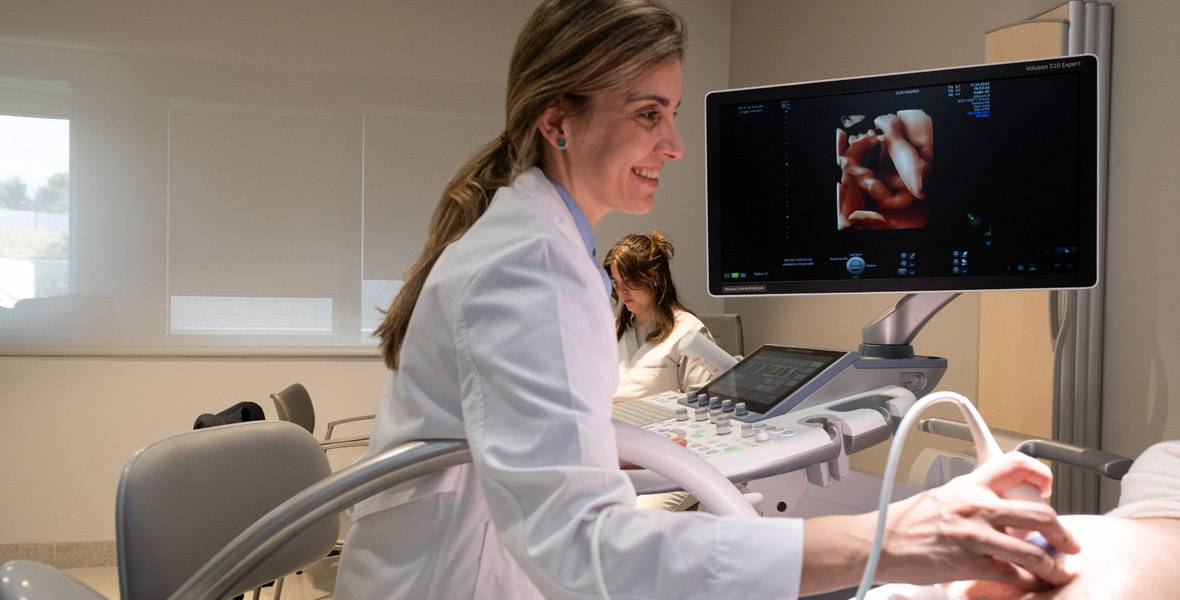Fertility
"We offer a more natural, ecological and respectful vision of women's health, from methods of natural fertility recognition, to the promotion of breastfeeding and 'humanized birth'".
DR. LUIS CHIVA DIRECTOR - PERSON IN CHARGE. GYNAECOLOGY AND OBSTETRICS DEPARTMENT

The Fertility Unit of the Clinica aims to understand why a couple does not get pregnant. To this end, it is committed to a restorative medicine based on the study of infertility in both women and men, and a stepwise therapeutic approach.
In recent years, gynecological and obstetric care has tended to avoid excessive medicalization and intervention. It opts for a more natural approach, promoting breastfeeding, vaginal delivery instead of cesarean section, strengthening the pelvic floor, among others.
In this line, the recognition of fertility indicators for their application in respectful family planning, without the need to use hormones, devices or elements that modify the normal functioning of the body or sexual intercourse, as well as the gynecological health of women, is gaining more and more attention.
Since its launch in 2018, the Fertility Unit has achieved an average pregnancy rate of over 40%. In the last year, it has seen more than 200 couples with a pregnancy rate of 46%.

Causas de la infertilidad
Actualmente, en España, la causa más importante de infertilidad es la edad al buscar su primer hijo, ya que a partir de los 35, y especialmente de los 40, los porcentajes de probabilidad descienden significativamente.
Sin embargo, existen otros motivos que pueden estar involucrados:
- Alteraciones de la ovulación.
- Alteraciones en las trompas.
- Permeabilidad ovárica.
- Endometriosis.
- Infecciones del tracto genital masculino o femenino.
- Problemas en la relación entre la secreción cervical y el semen.
- Alteraciones en la fase lútea: el cigoto no tiene una superficie óptima donde implantarse.
- Morfología uterina.
- Microambiente bacteriano del útero.
- Causas inmunológicas.

When studying the causes of infertility in a couple, it is essential to analyze both members of the couple simultaneously, since in 50% of those who do not have children involuntarily, a factor associated with male infertility is found, generally together with abnormal seminal parameters.
This diagnostic study of the male includes a review of the clinical and reproductive history, a physical examination, semen analysis -with strict adherence to the values of the World Health Organization-, and a hormonal evaluation.
In addition, depending on the clinical characteristics and semen parameters, other investigations may be necessary, such as sperm DNA fragmentation, genetic analysis, imaging tests, seminal and urethral infection studies.
Treatments addressed:
- Male infertility due to oxidative stress (MOSI).
- Minimally invasive treatment of varicocele (embolization and surgery where appropriate).
- Microsurgical vasostomy (robotic).
- Empirical medical treatment (hormonal and other stimuli).

Fertility Recognition Program
Our individualized learning program is organized in regular visits in consultation with an expert monitoring nurse and with the support of specialized gynecologists.
Learn about the program
Any woman can learn to accurately identify her fertile period and recognize changes in it, known as biological indicators of fertility. They make it possible to detect certain gynecological pathologies and women's health problems that may require treatment, especially if she is seeking pregnancy.
- 1 introductory session with the couple. (60 minutes).
- 8 follow-up interviews (60 minutes).
- Complementary gynecological ultrasound, if needed.
Fertility recognition may be more difficult in situations such as breastfeeding or perimenopause or if you have irregular cycles. However, the Clinic's learning program applies to these cases as well.
When to go to a specialized fertility unit?
Consultation is recommended if after one year of regular sexual relations, or after 6 months in patients older than 35 or with a gynecological or urological history, or previous chemotherapy, gestation is not achieved.
Fertility Unit Treatments
Recanalización tubárica
La microcirugía tubárica microquirúrgica o reversión de la ligadura de trompas es una técnica reproductiva que revierte la ligadura de trompas, y que alcanza una tasa de embarazo posterior de más del 65%.
La Unidad de Fertilidad de la Clínica Universidad de Navarra es el centro con mayor experiencia en esta técnica eficaz y sin riesgos posteriores asociados a las técnicas de reproducción in vitro, como los embarazos múltiples, los partos prematuros, la preeclampsia o diabetes gestacional.
Histerosalpingografía
Esta técnica radiológica permite ver si el útero tiene una forma normal o si existe alguna lesión dentro de la cavidad que pueda ocasionar la obstrucción de las trompas. Si existe obstrucción, se reemplaza la cánula por un catéter que limpia las trompas y permite su permeabilidad.
El éxito técnico de la histerosalpingografía y repermeabilización tubárica supera al 95%, y un 40% logra conseguir un embarazo en el primer año después de la recanalización, revirtiendo con éxito un problema que supone el 35-40% de los casos de infertilidad femenina.

























